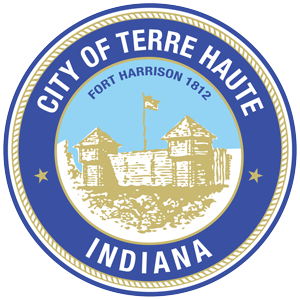The city of Terre Haute owns two cemeteries. The older of these is Woodlawn, which consists of forty acres and was opened in 1835, is located on North 3rd Street. The other cemetery owned by the city is Highland Lawn.
The first city cemetery was located at what is now known as Sixth Street and Ohio Street. When the growing city realized that the cemetery would not be large enough, they purchased the tract of land where Woodlawn is located. At that time, the bodies from the old cemetery and the Indian Orchard Cemetery (which was located on First Street) were moved to Woodlawn.
Highland Lawn, was opened in 1884 and has 139 acres. The first person buried was Samantha McPherson, age thirty, who died of typhoid fever. She was buried on October 29, 1884 in Section 2, Lot 6. There are twenty-three sections in Highland Lawn Cemetery.
The chapel was built in 1893 at a cost of $10,000.00. It was designed by architect, Jesse A. Vrydaugh. It is a fine example of "Richardsonian Romanesque" architecture popular from the early 1870's to 1900. The chapel was renovated in 1987 and was completed in March of 1988.
There are single and double monuments in the cemeteries. The larger the monument the more prominent, or more wealthy, the family. Section 18 is the only section with a limit on the size of the marker, where they are restricted to flat markers.
The mausoleums in the cemeteries are individually owned. They are of varying size with some having the capabilities of holding as many as sixteen. Some of these mausoleums were constructed over 100 years ago. They are constructed of granite and marble, and built on the lot.
The Heidenreich Company built the Bell Tower in 1894. The gateway arch was contracted to Edward Hazledine. The Terre Haute Stone Company did the stone work. A Rest House was built attached to the gate. This was built in accordance with the general scheme of the gate and is considered an architectural gem. It is the design of W.H. Floyd of Terre Haute, patterned in the Colonial architecture style. It is thirty-six feet long and nineteen feet wide. Our current office was originally built in 1909 as the Old Interurban Trolley Car Waiting Station and was later converted into an office.
Highland Lawn was placed on the National Register and State Registry of Historic Places in 1991. It is recognized as one of the most beautiful cemeteries in the country and the second largest in the state of Indiana.

Highland Lawn is an outstanding example of late 19th century Romantic (Victorian) landscape design. It is also significant for its Romanesque architecture. Designed in 1884 by Joseph Earnshaw, Highland Lawn exhibits the typical characteristics and details of Romantic landscapes; graceful, meandering paths, extensive plantings and grouping of trees and shrubs, and the selective placement of lakes, vistas, and open spaces. Earnshaw's design concept for the cemetery was the "lawn plan" in which existing landscape took precedence over the erection of large monuments. The cemetery also contains a number of remarkable examples of artistic landscape design and sculpture that reflect the 19th century use of funerary art as a demonstration of social standing. Today much of the original landscape design remains in tact and is well respected and maintained by the city of Terre Haute. The original plan can be seen in the Bell Tower.
Almost as an eerie welcome is that of the H. C. Dies stone you see upon entering the cemetery. Mr. Henry C. Dies was the Treasurer of Clinton Paving Brick Company. With two others, he founded West Clinton Junction, a small town east of Clinton, Indiana. Buried with Mr. Dies is his wife, Mary A. Dies.


